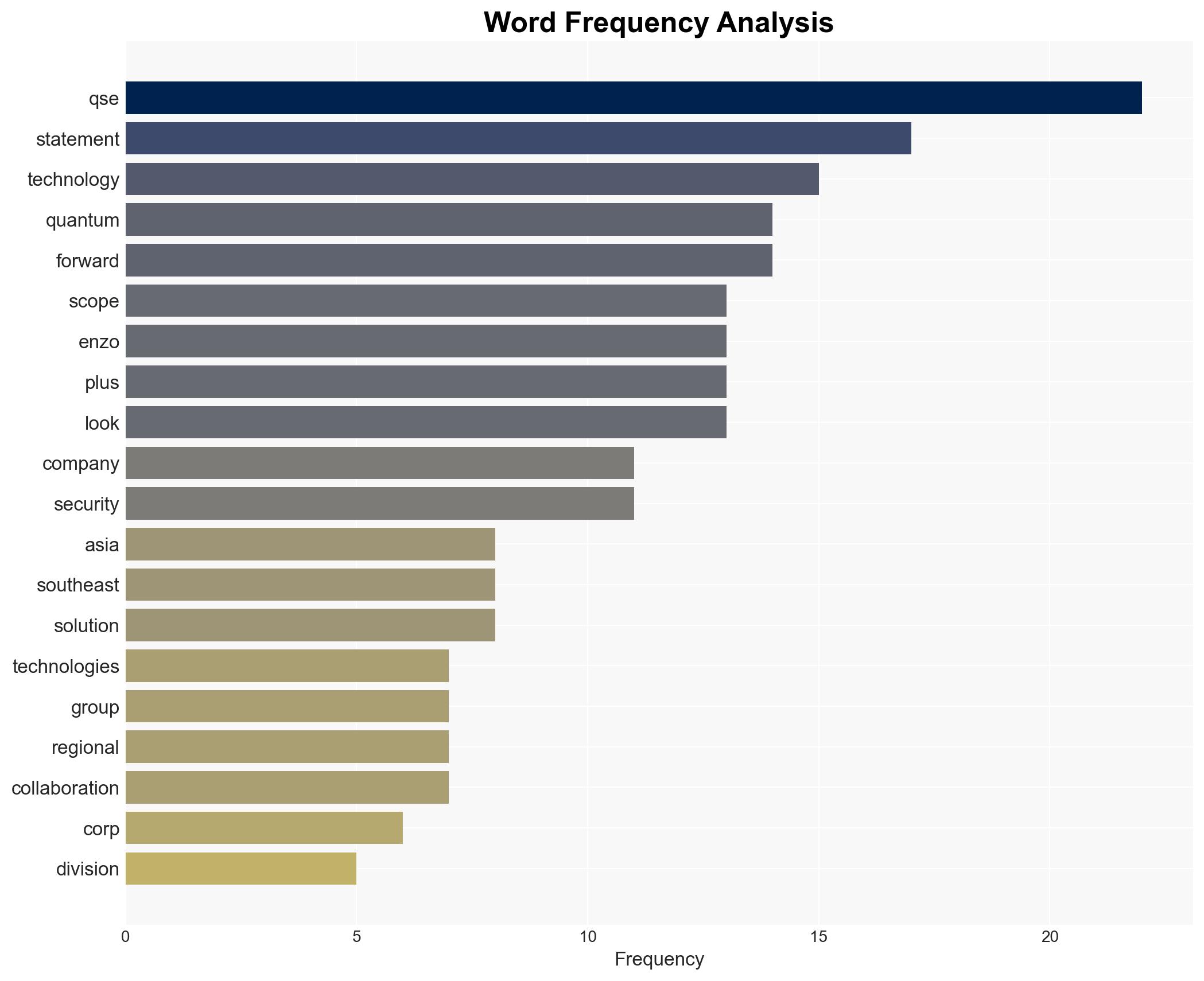QSE Group a Scope Technologies Division Collaborates with Enzo Plus to Accelerate Quantum Security Adoption Across Southeast Asia – GlobeNewswire
Published on: 2025-11-13
AI-powered OSINT brief from verified open sources. Automated NLP signal extraction with human verification. See our Methodology and Why WorldWideWatchers.
Intelligence Report: QSE Group a Scope Technologies Division Collaborates with Enzo Plus to Accelerate Quantum Security Adoption Across Southeast Asia – GlobeNewswire
1. BLUF (Bottom Line Up Front)
The collaboration between QSE Group, a division of Scope Technologies, and Enzo Plus is strategically positioned to enhance the adoption of quantum security solutions across Southeast Asia. The most supported hypothesis is that this partnership will significantly strengthen QSE’s market presence and accelerate the adoption of quantum security solutions in the region. Confidence Level: Moderate.
2. Competing Hypotheses
Hypothesis 1: The collaboration will successfully accelerate the adoption of quantum security solutions in Southeast Asia, leveraging Enzo Plus’s regional presence and expertise.
Hypothesis 2: The collaboration may face challenges in achieving its goals due to potential market resistance, regulatory hurdles, or insufficient demand for quantum security solutions in the region.
Hypothesis 1 is more likely given Enzo Plus’s established presence and network in Malaysia and Singapore, which are key markets for technology adoption. However, the success of this hypothesis depends on the effective execution of the partnership and the actual demand for quantum security solutions.
3. Key Assumptions and Red Flags
Assumptions: The demand for quantum security solutions is growing in Southeast Asia; Enzo Plus has the necessary capabilities and network to support QSE’s expansion; Regulatory environments in target countries are conducive to the adoption of new security technologies.
Red Flags: Potential overestimation of market readiness for quantum security; Lack of detailed information on Enzo Plus’s past performance in similar collaborations; Possible underestimation of regulatory challenges in different Southeast Asian countries.
4. Implications and Strategic Risks
The collaboration could lead to increased competition in the quantum security market, potentially driving innovation and lowering costs. However, failure to meet expectations could damage QSE’s reputation and financial standing. Political and regulatory changes in Southeast Asia could also impact the collaboration’s success, especially if data sovereignty and cybersecurity laws become more stringent.
5. Recommendations and Outlook
- Conduct a thorough market analysis to validate the demand for quantum security solutions in Southeast Asia.
- Develop a robust risk management strategy to address potential regulatory and market challenges.
- Engage with local stakeholders, including government agencies and industry leaders, to build support for quantum security initiatives.
- Best-case scenario: The collaboration leads to rapid adoption of quantum security solutions, establishing QSE as a market leader in Southeast Asia.
- Worst-case scenario: Regulatory barriers and market resistance hinder the adoption of quantum security solutions, resulting in financial losses and reputational damage for QSE.
- Most-likely scenario: Gradual adoption of quantum security solutions, with initial success in Malaysia and Singapore, followed by expansion into other Southeast Asian markets.
6. Key Individuals and Entities
Desmond Teo (Founder and CEO of Enzo Plus), Ted Carefoot (CEO of QSE Group, a Scope Technologies Division)
7. Thematic Tags
Cybersecurity, Quantum Security, Southeast Asia, Strategic Partnership, Technology Adoption
Structured Analytic Techniques Applied
- Adversarial Threat Simulation: Model and simulate actions of cyber adversaries to anticipate vulnerabilities and improve resilience.
- Indicators Development: Detect and monitor behavioral or technical anomalies across systems for early threat detection.
- Bayesian Scenario Modeling: Quantify uncertainty and predict cyberattack pathways using probabilistic inference.
- Network Influence Mapping: Map influence relationships to assess actor impact.
Explore more:
Cybersecurity Briefs ·
Daily Summary ·
Methodology





